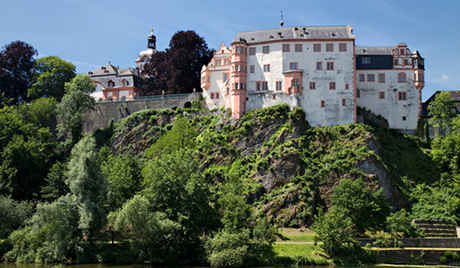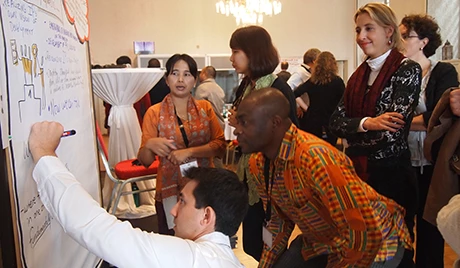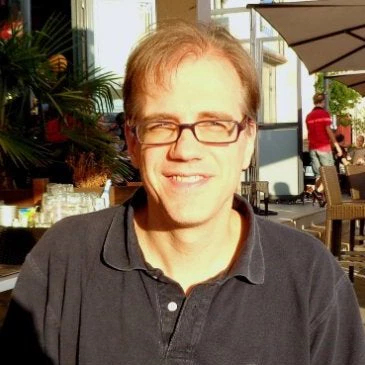
It is not often that you find Indigenous Peoples from around the world meeting in one of the most important baroque castles of Germany. Perched on a cliff, with a natural moat created by the river Lahn, the castle of Weilburg allows a bird’s eye view of the surrounding forest landscape.
These forests were not always lush and thriving. Centuries before, the construction of the castle led to massive logging in the adjacent forests and finally the ruling aristocrat ordered restricted use of timber for construction and introduced a new building code. As a result, Weilburg became the national center of a novel construction technique using clay and straw, which is now seen in towns across Germany.
Coincidently, a new approach to tackling deforestation is also what 80 Indigenous Peoples’ leaders, government representatives, civil society practitioners and international experts from 24 countries discussed this week at a three day workshop in Weilburg’s castle.
The central challenge was to identify practical approaches to ensure the full and effective participation of Indigenous Peoples in REDD+, a performance-based mechanism for reducing emissions from deforestation and forest degradation. The meeting was jointly organized by the Federal Ministry for Economic Cooperation and Development (BMZ), the Forest Carbon Partnership Facility (FCPF) and the UN-REDD Programme.
As custodians of the forest, Indigenous Peoples are key partners in the global effort to combat climate change by conserving tropical forests. 1.6 billion people around the world depend to some degree on forests for their livelihoods. At least 350 million people live inside or close to dense forests, and 60 million Indigenous Peoples are almost wholly dependent on forests for subsistence and income (pdf).
These numbers clearly show why full and effective participation of Indigenous Peoples is both a fundamental principle of REDD+ as well as a necessity for actually achieving its promised development benefits.
Participants at the workshop on Indigenous Peoples in REDD+ Processes held in Weilburg, Germany from September 10 to 12, 2013. - Photo: Janine Kriesel
In practice, however, Indigenous Peoples’ participation in the REDD+ process has proven challenging. We still see barriers to full and effective inclusion of Indigenous Peoples in REDD+ decision-making. Some of the most important barriers that we discussed during the workshop include:
- Insufficient participation in decision-making throughout the entire REDD+ Readiness process – starting from initial planning and design to more in-depth strategic planning – and during national REDD+-related policy making.
- Persisting capacity gaps, including the need for continuous capacity building to support Indigenous Peoples to organize themselves in politically effective ways and to ensure their leaders are accountable to the diverse communities and groups they speak for at the national level.
- Insufficient recognition by other stakeholders, particularly government officials, of the singular contributions that Indigenous Peoples can make to planning and decision-making processes. This is linked to missing recognition of their political relevance and the dominion Indigenous Peoples have over their native lands.
By the end of the meeting, I felt immensely grateful for this unique opportunity to talk, share, reflect, and plan with such a diverse group of talented people. What ultimately made this workshop a great success was the personal commitment of everyone involved. It is clear that those of us here in Weilburg are personally invested in making sure Indigenous Peoples have a seat at the table, from which they can voice their visions for development and REDD+.
In his closing reflections, Simon Whitehouse of the FCPF, emphasized that the active participation of colleagues from the FCPF and the World Bank is an indicator of the extent to which we take the workshop’s themes seriously. He added that "proactive attention to the link between indigenous identity and rights, indigenous livelihoods development, land tenure security, and working with governments that are at different points with regard to their willingness to engage with Indigenous Peoples present both opportunities and challenges for the way forward."
If it sounds complicated, it is. But Indigenous Peoples, like climate scientists, are used to thinking in the long term. As noted by Vicky Tauli-Corpuz, an indigenous activist from the Philippines and one of the workshop’s co-facilitators: "We wouldn’t even be here talking about getting to work on REDD if it weren’t for all the work that Indigenous Peoples have been doing for centuries to conserve their forests."
More than five years after the creation of the FCPF, Indigenous Peoples wanting to get something out of REDD+ are looking for much more than recognition of their place in the forest. But it’s a start.



Join the Conversation